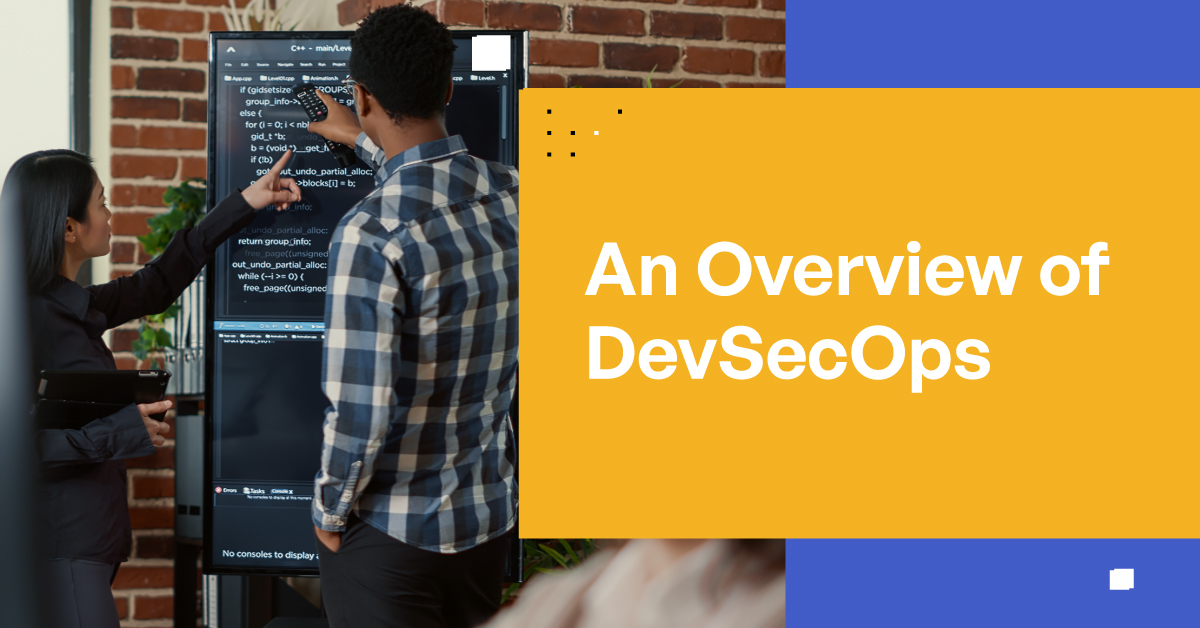DevSecOps: Integrate Data Security Into the Software Development Life Cycle
The transition to the cloud has revolutionized the software development process, allowing teams to create and deploy applications faster and more efficiently. As organizations strive for higher quality and cost-effective results, the traditional security protocols no longer suffice for robust and reliable protection. DevSecOps emerged as an innovative approach that combines development, security, and operations teams, and streamlines security practices into the DevOps pipeline. Such must be part of any cybersecurity risk management strategy.

DevSecOps successfully merges the processes of development, security, and operations into an integrated workflow and seeks to automate security checks throughout the development process. By placing security measures at the heart of the organization, the DevSecOps approach proactively prioritizes security, reducing risks and paving the way for the organization to meet its compliance requirements.
This ensures that all code is tested and inspected for security vulnerabilities before being released into production environments and establishes proactive and effective security measures within the pipeline. As organizations move toward continuous integration and continuous delivery, DevSecOps is the key to success, allowing teams to move faster while making security an integral part of their pipeline.
What Is DevSecOps?
DevSecOps aims to build security into the development process from the onset, with the ultimate goal of reducing vulnerability and security breaches that can occur within the software. This approach emphasizes constant, ongoing communication and collaboration between stakeholders and utilizes automation to ensure effective and timely checks and tests.
By bringing security into the development process right from the start, development teams are able to work on secure code instead of focusing on the security components after development has already started. This allows security to become a part of the development team’s core workflow, enabling teams to detect and address potential security issues early in the cycle.
The DevSecOps approach also helps to reduce the chance of introducing technology debt, which can be costly and time-consuming to address. Moreover, DevSecOps combines the strengths of security and development teams, while reducing friction through automation and collaboration. By encouraging collaboration between these different disciplines, it helps teams to create secure and high-quality code faster and without any headaches.
DevSecOps is a cost-effective and collaborative approach to software development that helps to ensure secure and reliable products. It works on bringing together the skills and expertise of security, development, and operations teams to create a smoother, faster, and more secure software development process.
Why Is Data Security Important in DevSecOps?
Data Security is a key component of DevSecOps because it helps protect sensitive data from malicious actors, as well as unauthorized access or theft. Data breaches cause significant financial losses, reputational damage, and legal liabilities. Data breaches can have wide-ranging and long-term effects, including data loss, identity theft, financial losses, regulatory fines, reputational damage, customer attrition, and compliance liabilities. Therefore, it’s essential for organizations to properly secure their data and ensure that their software is secure from the start.
DevSecOps is an approach to software development where security is integrated into the development and operations workflow. This includes incorporating security practices into every stage of the software development life cycle, from design and development to testing and deployment. By assessing and addressing security risks early on in the development process, organizations can reduce the risk of a data breach and ensure that their software is built to be secure and compliant with regulatory requirements.
Data security is just one component of DevSecOps, but it is essential for organizations to take a holistic approach to security and ensure that their entire software engineering process is secure. This includes leveraging automation and DevOps tools for timely detection and response to threats, as well as incorporating security into the continuous integration and continuous delivery process. Additionally, organizations should regularly conduct security assessments to identify vulnerabilities and ensure the security of their systems. By taking a comprehensive approach to security, organizations can protect themselves against data breaches and maintain the integrity of their data.
Best Practices for DevSecOps Data Security
Ensuring data security is an important part of DevSecOps. There are many best practices that can help improve the security of an organization, including:
Conduct Regular Security Assessments
Regular security assessments are essential to identify vulnerabilities and address security issues early on. This includes conducting regular penetration testing, vulnerability scanning, and code reviews to ensure that your software is secure.
Implement Secure Coding Practices
Secure coding practices help to prevent vulnerabilities in the code. This includes using secure coding standards, implementing input validation, and avoiding hard-coded passwords and credentials.
Use Encryption
Encryption helps to protect sensitive data from unauthorized access. This includes encrypting data in transit and at rest, using strong encryption algorithms, and managing encryption keys securely.
Implement Access Controls
Access controls help to prevent unauthorized access to sensitive data. This includes implementing role-based access controls, restricting access to sensitive data, and implementing multi-factor authentication.
Use Secure Infrastructure
Secure infrastructure is essential to protect data and prevent unauthorized access. This includes using secure cloud providers, implementing secure network architecture, and managing access to infrastructure resources.
Integrating Data Security Into the Development Workflow
Integrating data security into the development workflow requires a holistic approach that includes the following steps:
Identify Security Requirements
Identify the security requirements for your application, including the types of data that need to be protected, the regulatory requirements that apply, and the risk profile of the application.
Define Security Controls
Define the security controls that need to be implemented to address the security requirements. This includes implementing access controls, encryption, secure coding practices, and other security controls as needed.
Integrate Security Into the Development Process
Integrate security into the development process by including security tasks in the development workflow, such as code reviews, penetration testing, and vulnerability scanning.
Monitor and Manage Security
Monitor and manage security throughout the development process, including ongoing testing, risk assessments, and incident response planning.
Kiteworks Development Best Practices
DevSecOps is a critical methodology for building secure software. Integrating data security into the development workflow is essential to prevent vulnerabilities and protect sensitive data. By following best practices for DevSecOps data security, organizations can ensure that their software is secure from the start and avoid the risks of data breaches and other security incidents.
Kiteworks adheres to DevSecOps best practices that include regular penetration testing and employs bug bounties. The Kiteworks hardened virtual appliance begins with a bare installation of the Linux operating system, with only the absolute minimum number of libraries and system applications required for operation. Kiteworks DevOps then installs a highly curated set of third-party libraries. The list of utilized libraries is continuously scanned against a database of known vulnerabilities that ensure the Kiteworks hardened virtual appliance with required security patches and upgrades. Kiteworks also has zero unnecessary active ports or services.
In addition to the above, Kiteworks uses internal mechanisms to monitor and enforce strict policies on the behavior of the operating and file systems. If a Kiteworks hardened virtual appliance deviates from its original state, an alert is automatically sent to the administrator. Kiteworks also uses internal sandboxing, network policy enforcement, and other network protections. When serious vulnerabilities arise, the risk is dramatically mitigated by Kiteworks’ security layers and protections. For example, in the case of Log4j, its CVSS score was lowered from a 10 to a 4.
For more information on the Kiteworks hardened virtual appliance and Kiteworks’ DevSevOps approach, schedule a custom demo today.
Frequently Asked Questions
What Is the Role of Data Security in DevSecOps?
Data security is an important component of DevSecOps, as security breaches can have a significant impact on an organization’s bottom line and reputation. To ensure the security of sensitive data, DevSecOps teams must incorporate security into their development and operations processes, including measures such as identity and access management, data classification, encryption, and secure coding best practices.
How Is Automated Testing Used in DevSecOps?
Automated testing is an important element of DevSecOps, as it helps teams rapidly detect and address security vulnerabilities. Automated tests can be used to detect application flaws, assess the implications of new code, and detect security vulnerabilities early in the software development life cycle. Automated testing also helps teams to identify application changes which could potentially increase risk and take corrective action when necessary..
How Can DevSecOps Help Ensure Data Privacy?
DevSecOps teams can use a combination of tools and practices to ensure the privacy of sensitive data, including data masking and encryption, identity and access management, data classification, and secure coding best practices. These tools and practices can help teams to maintain the security of an application’s data, while ensuring that users’ data is protected and only accessed when necessary.
How Do DevSecOps Teams Measure the Effectiveness of Their Security Initiatives?
DevSecOps teams can measure the effectiveness of their security initiatives by evaluating the results of their automated tests, the rate of false positive incidents, and the rate of security incidents. Additionally, teams should track the number of vulnerabilities found over time and the time taken to fix them to understand where improvements can be made.
How Do Organizations Implement DevSecOps?
Implementing DevSecOps involves creating an integrated process which incorporates security from the earliest stages of the software development life cycle. This means that security must become part of the team’s culture, with the necessary tools, processes, and practices in place to ensure that security is not overlooked.
What Is the Difference Between DevOps and DevSecOps?
DevOps is an approach to development and operations which focuses on the automation of application deployments and operations. DevSecOps builds on this by integrating security into the process, so that security is considered throughout the development, testing, and deployment process.
What Tools Can DevSecOps Teams Use to Ensure Data Security?
DevSecOps teams can use a variety of tools to ensure the security of sensitive data, including data masking, encryption, identity and access management, data classification, and secure coding best practices. Additionally, teams should use automated testing to detect vulnerabilities in their applications, and use logging and monitoring to identify any suspicious activities.

